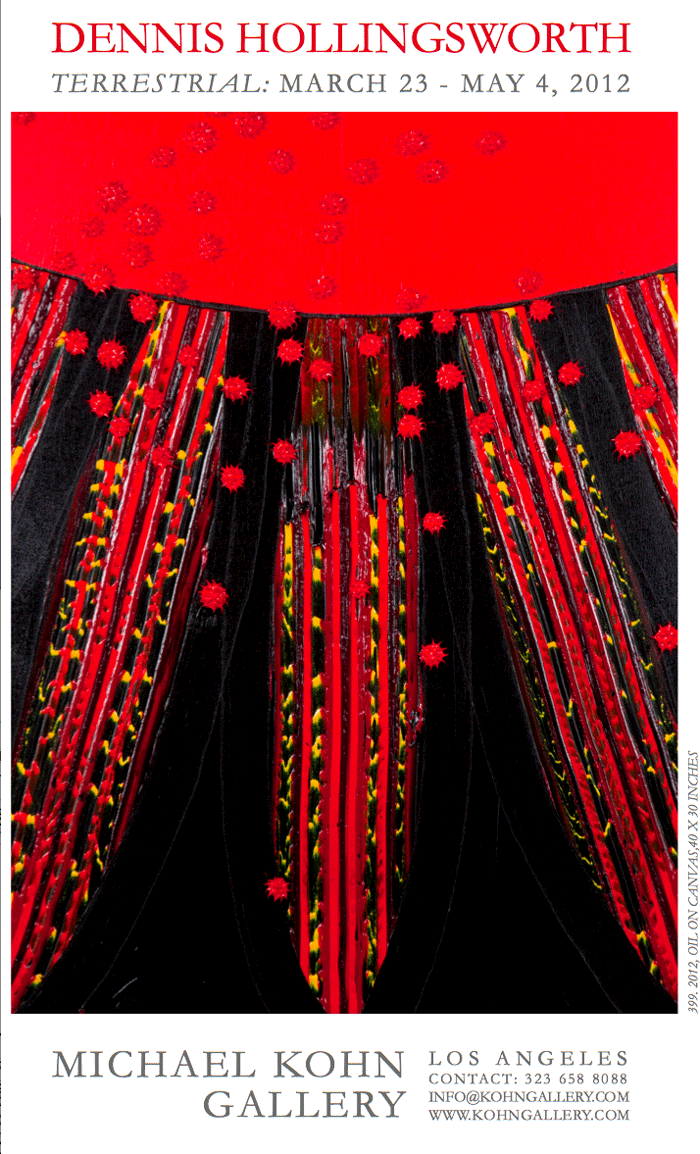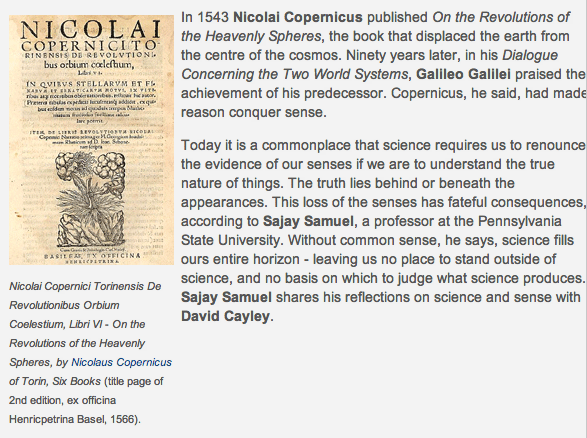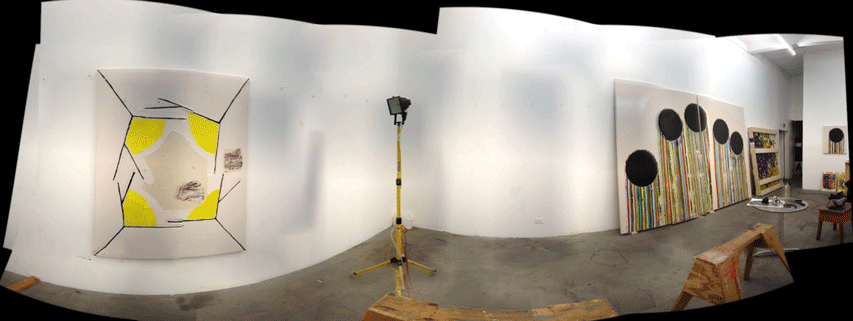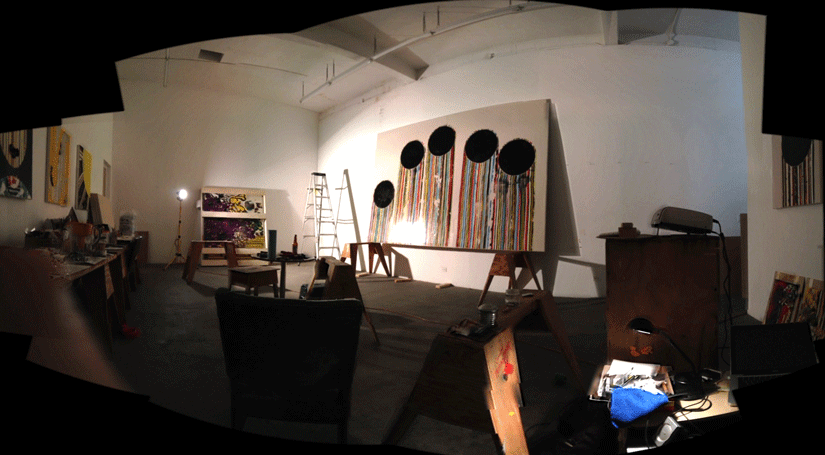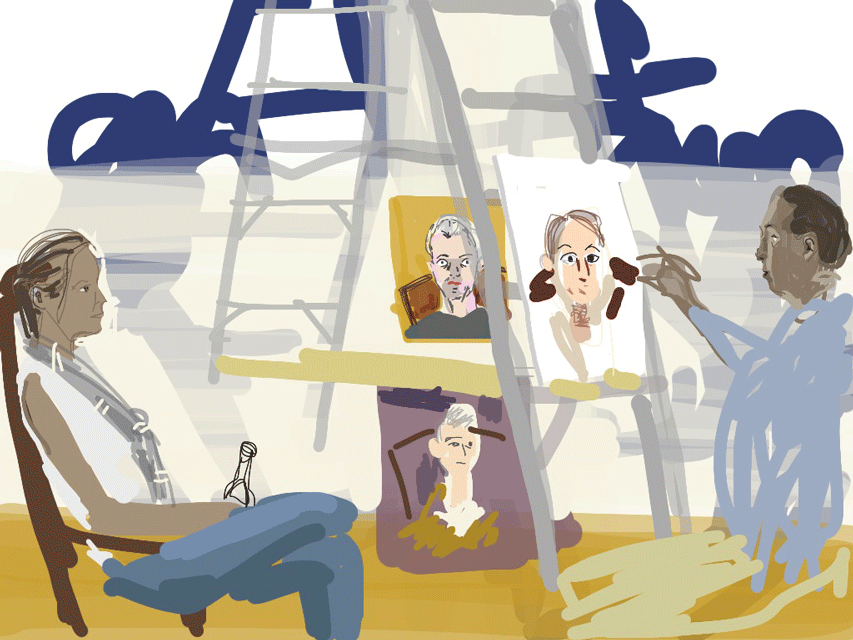February 28, 2012
The Conversation: Michael Shaw

I've blogged about Geoff Tuck's Notes on Looking before, I am definitely a fan of "Word Tiger" Tuck's work there. Recently, I've been listening to Notes On Looking's artist/correspondant, Michael Shaw, who runs a podcast operation called The Conversation: An Artist Podcast. Tag line: "one on one artist interviews, no b.s." I cherry picked a few (lots to pick from) and was able to embed them above. I know Charles Irvin, you can hear his personality here (a funny, wonderful, oddly spiritual guy) and I met Rowan Wood once, his interview here confirms my assessment that he's a very interesting person. I like The Conversation because Shaw tends to drill down into biographical material, a dimension normally left out of normative art analysis. Click on his link, Shaw/NOL has quite a robust archive for such a young operation.
February 22, 2012
Pin Up
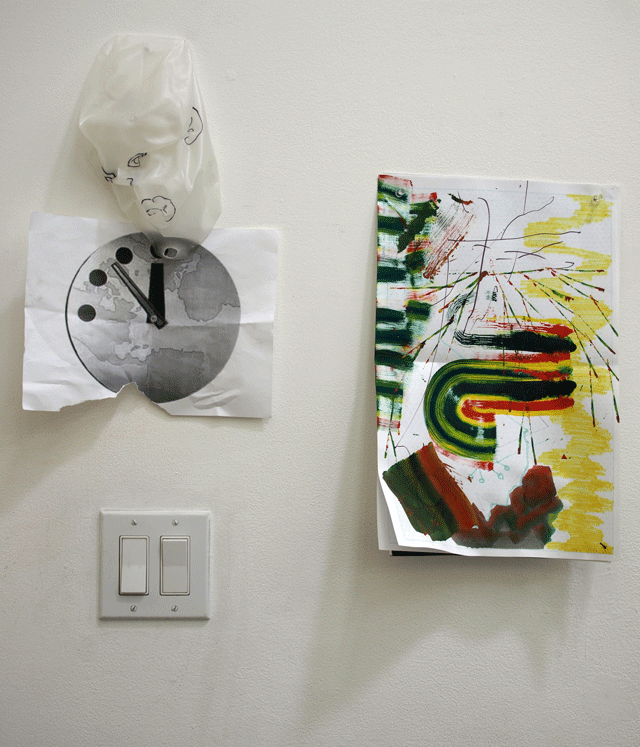
It's not unusual for casual stuff that you pin up on the walls of the studio to catch your eye. The clock piece was dropped off by neighbor Andrew Hahn, a referent for the big painting I just finished. The color piece is a nonchalant collaboration between Andrew and I, messing around with residual inks after one of his print sessions in his studio next door. The plastic is a a film of mat medium peeled from a gallon jug and marked in a way that made me think of Henry Taylor. It was the detail of branching lines that caught my attention.
Studio Music: Youssou N?Dour
Here is the musician's description from Wikipedia:
Youssou N'Dour (French pronunciation: [jusu nˈduʁ]; born 1 October 1959 ) is a Senegalese singer, percussionist, songwriter, composer, occasional actor and businessman. In 2004, Rolling Stone described him as, "perhaps the most famous singer alive" in Senegal and much of Africa. N'Dour helped to develop a style of popular Senegalese music known in the Serer language as mbalax, which traces from the conservative Serer music tradition of "Njuup" (the progenitor of Mbalax).
Here is N'dour's website.
Lyrics to the first video:
PRESIDENT:I am writing this letter
and addressing it to the future president of Senegal.
To you who wishes to become my president.
I am writing to you this letter so that I announce to you my hopes.I want abundant clean water
Electricity and less darkness
Good roads and hospitals
Good schools and enough jobsChorus: To you who wishes to become my future president
I write to you this letter
So to you I announce my hopesI want to see the farmer, the herder working
So that that no one will be hungry
And no one will cryWe the children are the future of this country
The building, that is good for us,
The destruction, that is bad for us
Ahead, always ahead.Chorus: To you who wishes to become my future president
I write to you this letter
So to you I announce my hopesI dream of a fast train from Dakar to Zinguinchor.
To you who wishes to become my future president
When will it ever become a reality?
I love Senegal.
I write to you this letter
Background on Senegal:
February 21, 2012
The Partially Examined Life
This blogpost is basically a shout out to the folks at The Partially Examined Life. PEL is a wonderful blog and podcast run -by their own self description, and I paraphrase- a bunch of guys who were once intent on an academic career in philosophy and then thought better of it. Which means that although they aren't higher ranking officers of the army of philosophy, they've been through boot camp and have seen a couple of tours of duty.
Or you might call it a reading club. What they are doing is to take specific texts, they read them and talk about it via Skype or something like that, they record and edit the conversation for publication. They know their stuff and they adjust their conversation to the general public, avoiding name dropping or arcana, they achieve their ideal of accessibility while keeping a sense of precision all the while. What I see in PEL is an evolution of scholarly life beyond the confines of the ivory tower. It's not an eclipse of the university, but a sprouting out into a world made possible by the democratizing capacity of this stage of the 21st century information age.
I've blogged about PEL before, that was when they published episode six, Leibniz and his Monadology. They already talked about Arthur Danto's "The Philosophical Disenfranchisement of Art" in episode 16 and they have just finished Episode 49: Foucault on Power and Punishment, both subjects are directly related to the artist's wheelhouse. The next episode will be #51: Semiotics and Structuralism (Saussure, Levi-Strauss, Derrida), a direct hit on the meat of what art schools have been marinating in at least as long ago as when I was in grad school in the early 90's. I have a suspicion that PEL will give a treatment to Deleuze and Guattari someday soon. I'm looking forward to that.
The art dialog is often grounded in late breaking fashionable thinkers whose authority reaches from within the world of letters from curators to writers/critics to philosophers and into the depths of the history of the humanities. Each thinker is a chain of conversation, and there are many conversations to become acquainted with. I takes a lifetime for the average person to wrap a head around it all. If at all. Recently, I blogged about academia and student loan debt (initially titled "Apropos of the Next Blogpost", now changed to Debt Smurfs) and I was going to link the idea of a failing financial system of higher education with its inadequacies in terms of a proper preparation in the liberal arts. Churlish, that is the word for that thought. I instead want to promote efforts like The Partially Examined Life as an important remedial or auxiliary or continuing education in philosophy. What they are doing is beautiful because firstly, it's for its' own sake, because of the generosity of the public service that it is, and for what it could be, or is becoming. PEL is part of the thousand flowers blooming.
If you follow the podcasts, follow the blog too. They have a lot of interstitial material between podcasts: videos, links, commentaries by the merry band of PEL and the commenters are box of sharp knives. Recently, I gleaned this gem from a comment stream: about science and common sense, a conversation with Sajay Samuel, a professor at the Pennsylvania State University, via CBC Radio's How To Think About Science. It's about science, its illusions, the empire of conceptuality, about sensation, common sense and the material world as we experience it. It's about restoring the importance of the qualitative world and putting the quantitative world in perspective... all this from a train of thought in blogposts and commentaries provoked by a recent podcast on Episode 50: Pirsig?s ?Zen and the Art of Motorcycle Maintenance?. Good stuff.
February 20, 2012
February 19, 2012
Debt Smerfs
Ha ha, funny, right?
Now ponder this::
Consider an individual who is a visibly poor credit risk. He would like to borrow money to blow on consumption and then stiff the lender, but since he cannot create credit, he has to live within his means.Now a lender comes along who can create credit out of thin air (via fractional reserve banking) and offers this poor credit risk $100,000 in collateral-free debt at low rates of interest. Who is responsible for the creation and extension of credit? The borrower or the lender? Answer: the lender.
In other words, if the lender is foolish enough to extend huge quantities of credit to a poor credit risk, then it's the lender who should suffer the losses when the borrower defaults.
This is the basis of bankruptcy laws--or used to be the basis. When an over-extended borrower defaults, the debt is cleared, the lender takes the loss/writedown, and the borrower loses whatever collateral was pledged. He is left with the basics to carry on: his auto, clothing, his job, and so on. His credit rating is impaired, and it is now his responsibility to earn back a credible credit rating.
The debt is discharged and the borrower must live within his means without relying on credit. But he is also free of the burdens of servicing the debt.
If the lender is forced into insolvency due to the losses, then so be it: lenders that cannot differentiate between good and bad credit risks should go under and disappear: that's what happens in a competitive, transparent capitalist economy. Fools who create credit and extend it to poor credit risks must be eliminated from the system as quickly as possible lest they destroy more capital in the future.
The potential for loss and actually bearing the consequences from irresponsible extensions of credit was unacceptable to the banking cartel, so they rewrote the laws. Now student loans in America cannot be discharged in bankruptcy court; they are permanent and must be carried and serviced until death. This is the acme of debt-serfdom.
February 18, 2012
Kierkegaard/ Waking Life
So...
So, I was talking to Bart and Adam at lunch at Chinatown's Via Restaurant the other day and Adam mentioned that he was becoming interested in S?ren Kierkegaard. That piqued my interest not only for philosophy in general and existentialism in particular but also because Adam was raised in an ashram in Texas; and I wonder how he will process this perspective.
I told him about The Partially Examined Life, a podcast and blog that I love "by some guys who at one point set on doing philosophy as a living, but thought better of it", and that PEL published a show on Kierkegaard, highly recommended. It had been a while since I heard it, so I listened to again it as I worked in the studio. Guest podcaster Daniel Horne has a brilliant summary of the incommensurable philosopher's worldview at time = 3:30. They mentioned in passing, a movie called Waking Life and the dialog by a character in that movie (Robert C. Solomon) who must have been their professor once upon a time. There are a lot of gaps in my movie literacy, and this is one of them. I guess it's never too late to fill one in.
I looked it up and lo! YouTube has it, the whole movie. What luck!
I got swept up.
Here is the key graf that PEL referred to in the Kierkegaard podcast:Philosophy Professor: The reason why I refuse to take existentialism as just another French fashion or historical curiosity, is that I think it has something very important to offer us for the new century. I'm afraid we're losing the real virtues of living life passionately in the sense of taking responsibility for who you are, the ability to make something of yourself and feel good about life. Existentialism is often discussed as if it's, a philosophy of despair, but I think the truth is just the opposite. Sartre, once interviewed, said he never really felt a day of despair in his life. One thing that comes out from reading these guys is not a sense of anguish about life so much as, a real kind of exuberance, of feeling on top of it, it's like your life is yours to create. I've read the post modernists with some interest, even admiration, but when I read them I always have this awful nagging feeling that something absolutely essential is getting left out. The more you talk about a person as a social construction or as a confluence of forces or as fragmented of marginalised, what you do is you open up a whole new world of excuses. And when Sartre talks about responsibility, he's not talking about something abstract. He's not talking about the kind of self or soul that theologians would argue about. It's something very concrete, it's you and me talking, making decisions, doing things, and taking the consequences. It might be true that there are six billion people in this world, and counting, but nevertheless -what you do makes a difference. It makes a difference, first of all, in material terms, it makes a difference to other people, and it sets an example. In short, I think the message here is that we should never simply write ourselves off or see each other as a victim of various forces. It's always our decision who we are.
Here is a link to a Wired article about the remarkable animation that director Rick Linklater pulled off.
February 17, 2012
Merely Retinal
Marcel Duchamp (1887?1968) has been aptly described by the painter Willem de Kooning as a one-man movement. Jasper Johns has written of his work as the "field where language, thought and vision act on one another." Duchamp has had a huge impact on twentieth-century art. By World War I, he had rejected the work of many of his fellow artists as "retinal" art, intended only to please the eye. Instead, Duchamp wanted, he said, "to put art back in the service of the mind."Point taken (as every art student has a duty to learn), but every argument requires artifice after all. Sight can never divorce the retina from the mind.
Here is another video from thegnome54 :
February 16, 2012
February 15, 2012
R.I.P.: Antoni Tapies (1923-2012)
Antoni Tapies and Barcelona from Philip Hartigan on Vimeo.
Here is an article about him from the Art Newspaper.February 14, 2012
Studio Music
T.Rice, nice.
I fell down a rabbit hole called SoundCloud. Let's let Wikipedia weigh in with the description:
SoundCloud was originally started in Stockholm, Sweden, but was established in Berlin, Germany in August, 2007 by sound designer Alex Ljung and artist Eric Wahlforss. It had the intention of allowing musicians to share recordings with each other, but later transformed into a full publishing tool which also allowed musicians to distribute their music tracks.A few months after it began operating, SoundCloud began to challenge the dominance of MySpace as a platform for musicians to distribute their music by allowing recording artists to interact more nimbly with their fans.
In a 2009 interview with Wired, co-founder Alex Ljung said:
?We both came from backgrounds connected to music, and it was just really, really annoying for us to collaborate with people on music ? I mean simple collaboration, just sending tracks to other people in a private setting, getting some feedback from them, and having a conversation about that piece of music. In the same way that we?d be using Flickr for our photos, and Vimeo for our videos, we didn?t have that kind of platform for our music.?
I got into this via weblogs such as Who's Gonna Take the Weight. Highly recommended, you can explore the various artists via this link.
February 13, 2012
The Hidden Structure of a Square
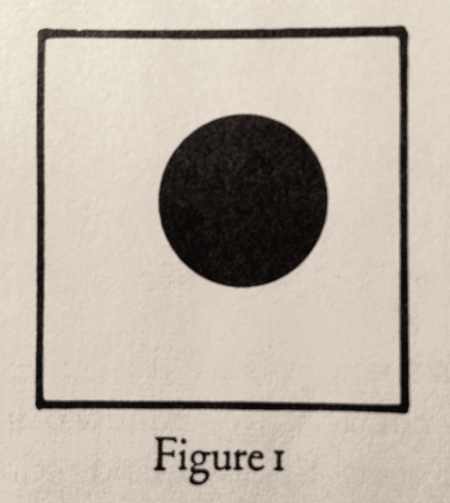
Art and Visual Perception, Rudolf Arnheim, 1954. Page 1, figure 1.
More Arnheim:
A snip:
In all of your works on visuality and art, certain concepts are especially important: structure and tension, order and disorder. Can one say that images are the basic principle of "the order of things," as Michel Foucault would call it, that holds the world together with "figures of knowledge?" Yes, that is definitely important. You see, this is the fundamental difference between me and Siegfried Kracauer. For Kracauer the world was raw material; from this concept he, in his Theory of Film, derived the definition of the photographic and filmic image as contributing to the "rescue of outer reality" and introducing physical nature in its original state. But images do not imitate reality, they hint at it. They have the ability to make the essential part visible, and are thereby a fundamental principle for understanding the world. Vision and perception are not processes that passively register or reproduce what happens in reality. Vision and perception are active, creative understanding. You have to imagine the following: When we observe something, then we reach for it; we move through space, touch things, feel their surfaces and contours. And our perception structures and orders the information given by things into determinable forms. We understand because this structuring and ordering is a part of our relationship with reality. Without order we couldn't understand at all. Thus in my opinion the world is not raw material; it is already ordered merely by being observed.
SketchBook
Time 0:10 I like the Brush application on my iPad. It's simple but the tools available are more than sufficient for a broad range of expression. Unlike a "real" sketchbook, you won't run out of pages, you can send and copy as you want, and you can play back the sequence of strokes in a way that might reveal a train of thought.
So somewhere along the way, I thought maybe I could film the playback it and show it to you.
Time 0:13 It so happens that the proportions of the screen is identical to the dimensions of the canvas (8'x12'), nice.
Time 0:15 The preconception makes its appearance. I resist it.
Time 0:20 A previous painting was fun/interesting/potent. I wonder if it could be as good at a larger scale?
Time 0:28 Squish the circle/sphere into the rest of the space. Goggles.
Time 0:33 No.
Time 0:38 I like the black. It's a soft black hole, energy flows as if down a drain. Malevich, all the way.
Time 0:40 Could I paint something like this. It is a painting from 2005 called "Icebergs, Continents, Universes.", I showed it at Tanya Rumpff's gallery in Haarlem, Netherlands. I'd like to see it again, paint it again.
But could it be done in black?
Time 0:42 No. And especially not with a black Malevich square.
Time 0:57 Back to Supremely So.
Time 1:02 No.
Time 1:10 Sunshine. Again.
Time 1:23 No.
Time 1:30 Figure it out.
Time 1:36 I'm becoming aware of the ability to view the playback, to be able to animate with this thing. I'm starting to devise a way to record this and post it on the blog/YouTube.
Time 1:39 Stop that self conscious shit. The entry into the big painting is the task at hand.
Time 1:46 These rays. They could tesselate.
Time 1:50 Madness.
Time 1:51 Big black lines are nice. There is a possibility to draw boldly, command the canvas.
A huge face like sugar.
Time 1:53 What if I could turn Supremely So and link ray-to-hole across the canvas?
Time 1:58 No. At least not yet.
Time 2:01 Let's make a torso for the hell of it.
Time 2:06 Let's get serious, here.
Time 2:08 Back to Supremely So in torsion.
Time 2:17 An array.
Time 2:18 No, at least not yet.
Time 2:20 What was that first mental image I had so long ago?
In the geometry of Orbital, the center of the circle was well outside and off center in relation to the geometry of the canvas. For this painting, the points of reference will be outside of the building. A problem that could be part of a solution, according to the premise.
Still, it's too close to the other paintings, running on a format makes sense when it can adjust to new circumstances well. It would be an increase in scale, but that's all it would be.
Time 2:25 What if I jammed both dominant ideas together?
Time 2:27 Run away!!!
Time 2:35 Blah.
Time 2:39 Start again.
Time 2:43 Supremely So, So, So, So, So.
Time 2:25 They are like fingers. Finger nails. Goth kid.
Time 2:53 I traced my hand on the screen. Five fingers.
Now I have a ranking of height with five referents.
Time 3:00 Do it again, better.
Time 3:09 Transit of the planets. Arc of the Ecliptic. Ellipsis. Eclipses. The other side of the black holes pour, not suck.
Fingers press on the other side of a glass-pane-picture-plane heavy with kaleidoscopic condensate.
Time 3:13 I was listening to SoundCloud at the time, searching Q-Tip for any artist so inspired. And there are a lot of them. I decided to download and use T.Rice's work for it (Creative Commons is in effect and ok as far as I can tell).
Time 3:27 So it was a nice sign of kismet when the lyrics matched the effort in making the video. A blessing.
February 11, 2012
February 9, 2012
Jim Murray
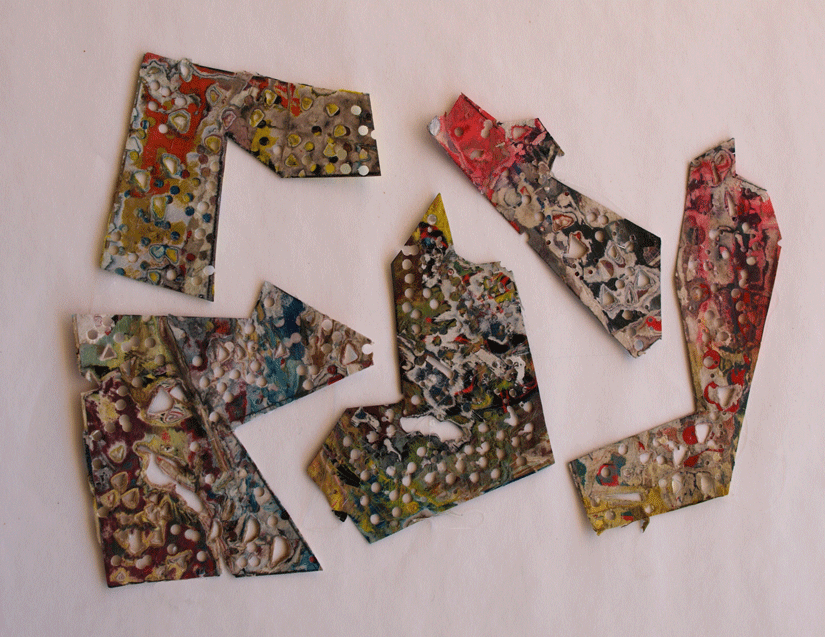
"diminished chord" chromo galaxies by Jim Murray, 2011.
Last December, I was delighted to receive this piece from a reader of this blog, Jim Murray. We've kept up a rambling conversation via email over the years, Jimmy has a wonderful way of expressing himself with the written word. I asked him to send me a foto of his recent work and one day, boom, here I have a strange kind of unhinged or otherwise unattached collage (collage always involves a glue of some kind, right?). Something to think about, there. To give you a sense of what I mean in terms of his wordplay, (I don't think Jimmy would mind the reveal) here is a cut and pasted a paragraph from a recent missive:
i always liked french kats like jaques villegle, roger haines..i remember seeing a villegle in pau (s france)..and in a galleriest"s from bergamo ,who was a friend, house. I always liked collage its like they say @ the medium> {immediate to the paws, cheap to the pocketbook, conceals/reveals the adeptness/lack thereof of the tinkerers mindfingertip skilz}...and usually its flat ergo easy to cart around..so when i lived all over and the kids mounted up i didnt have a ton of room to work on figuring out al these chromo-palletes which was my intent..so that i could perhaps paint..(im a failed painter)..the hole punch was a hat tip to the impressionists who seemd to have been the early birds who made the canvas surface respire...? and i could get an immmediate response of the color relationship )madruga-market-nude skin-water with everything..amish clothesline) by glancing at the holes and the paper color under it so i tinkered with them for a few decades....then in the early 90s we had to move out of a farmhouse cuz someone bought it and we had to book. A bigishcombine like thing i tried was in the back of the pickup..it was amrch snowstorm and the thing fell out busted..so i said nufa this gonna thin em out so i started to belt sand them so i could do more jazz refrain layering..and then i liked the look provaocative of the agate hunting days of my youth..Well eventually had a show at flanders 7 years ago..but then some of the remants of that 25 year retro got rained on in that old schoolhouse!@#$%^ so i started cutting them up making smaller "openings" as leigh salgado labelsem... cuz i figured they would mold..if not..then i i have a collage around for a few years + and i am not tickled with the final chromatic resolve i find th epeices which trigger ojo joy and cuttem out..(sometimes i share a few with artists/friends like denny cuz they get the lingo and im kinda isolated here..sort of (no complaints) ur always welcome to come out and stay a spell...do some art the schoolhouse is empty in summer cept4me...Thanks so much, Jimmy! I appreciate the recuerdo.
UPDATE: Here is Jacques Villegl? in Wikipedia.
February 7, 2012
Robot Vision
Robot readable world from Timo on Vimeo.
I don't blame some of the audience of this blog for thinking that I post items in a random manner, and this one would seem to be a prime example. I rely on my intuition to drive each blogpost, and I can't always explicate them... or at least, I don't want to drive an apologetic along with every apparent-off-the-wall blogpost.
Let this one be an object example for the rest: Robot Vision is about the overlay of computer cognition atop human cognition, and this was exactly the nature of my job so many years ago when I was a fleet sailor stationed aboard the USS Truxtun, working as an operations specialist (swabbie parlance: "scope dope"). At that time, the state of the art in radar technology was the beginning of the merger of radars to computing. We had to tell the computer what was out in the world by constructing a virtual picture in symbolic visual language over a radar picture that was a representation of reflected radio frequency emissions. This picture of the world was shared between the crew and captain and linked to aircraft and other ships in the formation. That was aeons ago, and I can only imagine what the state of the art is today in the fleet, but the point of this post is that like GPS, this technology has long been disseminated to the public. This video is a peek into our near future.
In my paintings shortly after getting out of grad school, I ran a program that was intended to restart painting after several decades of academic proscription against painting proper. I took what I understood to be Ed Ruscha's program (painting as wordplay and wordplay as painting), I interpreted this in the light of the current prohibition against the traditional arts as text as the closed and locked gates to the garden of visuality. By imagining myself as an actor who was reversing this program (Here is an example of a painting from 1992), The textual element was morphing into visual shapes via distortion and formal liberty. As time went on, I drove the textualist foreground into a kind of chameleon creature that sought to blend and merge with the background, a unification of opposing facets (here's an example and a detail too).
I think that I can see in these examples and I hope that you can too, the connection between the merging of computer and human cognition... therefore, the video on Robot Vision.
And what about the previous blogpost, Giorgio singing to a fast food worker? (Check out his site, nice guy with a cool family and friends, a blessed life.) Well, he's an exemplar for this maxim: Kindness requires no theory.
February 4, 2012
February 2, 2012
February 1, 2012
Costa Concordia, Sea Charted.
Reconstruction of the Costa Concordia, Narration by John Konrad, AIS Data by www.QPS.nl from gCaptain.com on Vimeo.
